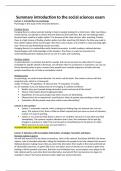Resume
Summary Introduction to the Social Sciences
- Cours
- Établissement
A summary of the Utrecht University course 'Introduction to the social sciences', containing Kahneman, psychology, sociology, behavioural economics and related subjects.
[Montrer plus]



